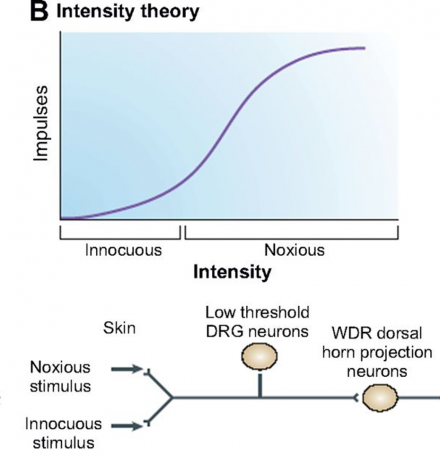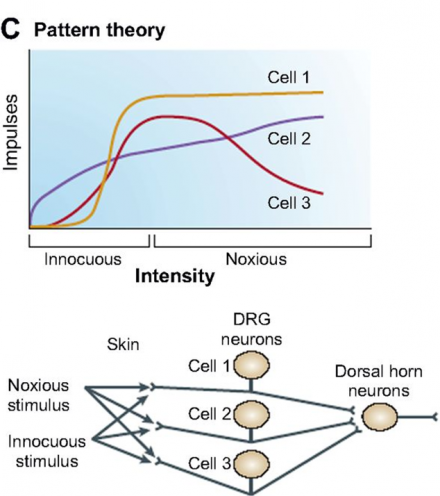Pain can be defined as an unpleasant sensory and emotional experience associated with actual or potential tissue damage, or described in terms of such damage (International Association for the Study of Pain).
In this section, you will learn about the development of pain theories and the basis for our current understanding of pain.
Ancient Societies: Pain Without the Brain?
Ancient Greece
Hippocrates asserted that pain was the result of imbalances in the vital fluids. Aristotle, on the other hand, asserted that pain was due to the gods and evil spirits, which entered the body via an injury.
The brain was not believed to have any direct influence; for years the heart was considered to be the center for pain sensation.
Early Christianity
Almost all religions have addressed human suffering and pain. Pain was often believed to originate with the gods. In Christian writings, pain has had contradictory meanings. Often, it appears to be the result of sin, so that pain is equated with a form of divine punishment.
Pain was also presented as a trial or test of a person’s faith. In these circumstances, pain was seen as a wound that God inflicts, lovingly, to humble and to discipline (Morris, 1999).
Our judgment of those with pain as weak or undeserving of our sympathy may be tied to this moral overtone and may change as popular morals shift. For example, gout (a congenital form of arthritis) was once viewed with disdain, much like modern day sexually transmitted diseases, because it was associated with the lavish lifestyle of the rich and decadent (Morris, 1999).
Cartesian Theory of Pain (DeCartes)
Descartes suggested a model in which the human body responds to pain as a machine, with appropriate responses based on avoidance of further damage. These responses were reflexive and highly predictable.
He thought that the system was based on hydraulics, so that the brain directed fluids throughout the body and this drove the behavioral output.
The idea that the intensity of pain is directly related to the amount of tissue damage sustained was first proposed by Descartes, and has a lasting hold on our assumptions about pain. The patients whose pain is the most challenging to treat are those with pain that seems to be disproportionate to their level of injury, in part because this defies our expectations.
Theories of How Pain is Encoded
- Specificity Theory
- Intensity Theory
- Pattern Theory
- Gate Control Theory

*image: Journal of Neurophysiology, 2013;109:5-12
Reference
(Perl, 2007)
Specificity Theory of Pain
Considers each modality, such as touch versus pain, as encoded in separate pathways.
Touch and pain stimuli are encoded by specialized sense organs. Impulses for each modality are transmitted along distinct pathways, which project to touch and pain centers in the brain, specifically, the dorsal root ganglion (DRG).

*DRG image: pain-consultant.co.uk
Intensity Theory of Pain
Relies on no distinct pathways for low- and high- threshold stimuli. Rather, the number of impulses in neurons determines the intensity of a stimulus.
The primary afferent neurons synapse onto wide-dynamic range (WDR) 2nd-order neurons in the dorsal horn of the spinal cord, where low levels of activity encode innocuous stimuli, and higher levels of activity encode noxious stimuli.

Pattern Theory of Pain
Posits that somatic sense organs respond to a dynamic range of stimulus intensities.
Different sense organs have different levels of responsivity to stimuli. A “population code”, or the pattern of activity of different neurons, encodes the modality and location of the stimulus.

Gate Control Theory of Pain
Proposes that both large (A-fibers) and small (C-fibers) synapse onto cells in the substantia gelatinosa (SG) and the 1st central transmission (T) cells. The inhibitory effect exerted by SG cells onto the primary afferent fiber terminals at the T cells is increased by activity in A-fibers and decreased by activity in C-fibers.
The central control trigger is represented by a line running from the A-fiber system to the central control mechanisms; these mechanisms, in turn, project back to the Gate Control system. The T cells project to the entry cells of the action system:
+, excitation; −, inhibition.

Biopsychosocial Model of Pain
Scientific research has clearly shown that pain is not simply a neurophysiological phenomenon; many factors influence our pain perception.
The sensory stimulus associated with injury is the primary/central input. Unique biological factors such as genetics and physiology have a big role in our individual perception of pain.
Additionally, psychological factors like personality and mood, and learned behaviors like coping strategies, can also affect how we experience pain and its impact on our quality of life.
Biological factors, specifically the genetic and physiological mechanisms of pain, will be taught throughout the course, but these factors cannot be considered in isolation from the sociocultural and psychological factors.
Biological Factors include tissue damage, genetic factors, physiological mechanisms of pain
This learning activity uses the biopsychosocial model as its framework.
However, social aspects set the framework for how we react to pain. They determine what is acceptable as well as what is taboo in how we deal with pain.
Sociocultural Factors include ethnicity, family history and cultural factors.
Culture sets boundaries for how we experience and describe our pain. Several research reports highlight the fact that people from different cultural heritages respond somewhat differently to painful stimuli.
Psychological Factors include negative mood (anger, anxiety, depression), coping strategies and social learning.
Timeline of Modern Pain Discoveries
Pain is a relatively young science as it was previously considered a normal part of life. This history of major findings outlines when and how our understanding of pain evolved over time. Four important dates are displayed.
Explore other noteworthy events along the timeline by hovering over each date.

Test Your Knowledge
Question 1
The most common cause of oral and facial pain is:
Question 2
Based on one's spiritual beliefs, an individual may think that pain and suffering is necessary.
Question 3
Individuals with pain should be encouraged to endure as much pain as possible before resorting to a pain relief measure.
Question 4
Anticipating pain relief by rubbing the site of pain demonstrates which theory?
Question 5
If there is no brain, there is no pain.

